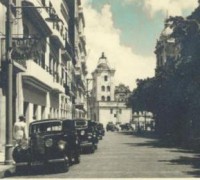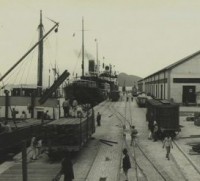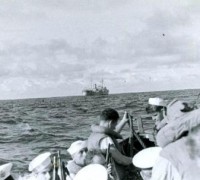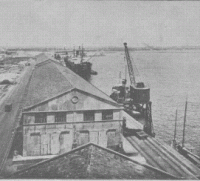- COMMANDER SOUTH ATLANTIC
4)ADM INGRAM FIRST VISIT
Between the arrival of Lieutenant Commander Hodgman at Recife, and the first call paid by Admiral Ingram, only one U S warship entered the port. This was the cruiser Vincennes which arrived on March 17, 1941, remaining three days before leaving for Capetown. The Vincennes did not belong to the Admiral’s force and never came again. Her visit was pure routine and had no bearing on subsequent developments.
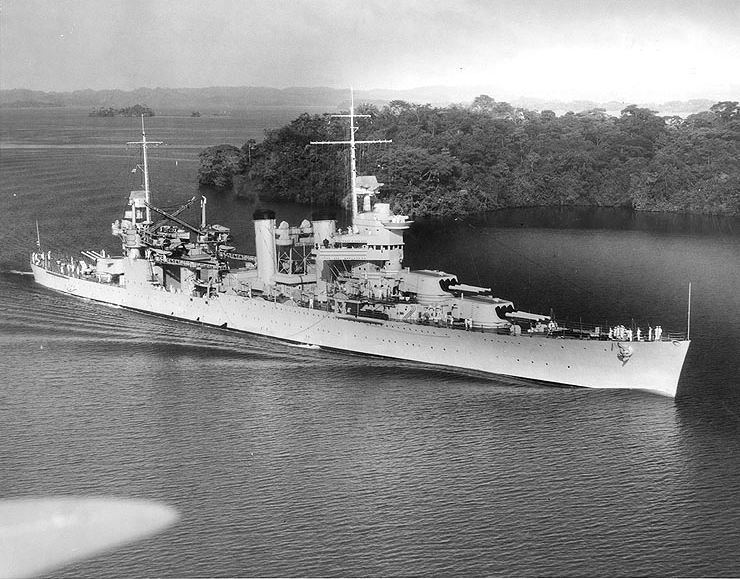
CA 44 VINCENNES. The first US Navy ship ever to visit Recife
Meanwhile, warships were preparing to visit Brazil in connection with the world emergency. On January 11, 1941, Rear Admiral, later Vice Admiral Jonas Howard Ingram hoisted his flag in the USS Memphis at Guantanamo Bay, Cuba, as Commander Cruiser Division Two, being also designated Commander Task Force Three, with additional duty as Commander of the Caribbean patrol. This patrol, made up of 36 seaplanes based on San Juan and Guantanamo, had reconnaissance duty extending from Key West to Trinidad, with the additional responsibility of keeping under surveillance the Vichy French Naval Forces, then based at Martinique.
Cruiser Division Two consisted of the Memphis (Flag), Cincinnati, and Milwaukee, all Light Cruisers, to which the Omaha, also a CL, was later added. Admiral Ingram soon saw the advisability of turning over the Caribbean Patrol to the Commandant of Naval District Ten at San Juan, who at that time was Admiral Spruance. He suggested this to the Commander in chief, who approved the idea, and the transfer took place at once. Release from this responsibility gave the Admiral freer hand for operations in the south Atlantic, to which he was soon assigned.
In March he went to the United States, and on the 24th had a conference with the Commander in Chief, Admiral King. The instructions he received then were to go to the South Atlantic with Cruiser Division Two, on neutrality Patrol. The Division should be based at on San Juan and Guantanamo, while Recife and Bahia, in Brazil, should be used as replenishing ports.
The area for patrol included the triangle formed by Trinidad, and the Cape Verde Islands and the hump of Brazil. The USS Patoka, an Auxiliary Oiler, was assigned as “triple threat” station ship, and would serve as tanker, tender, and supply vessel for the force. Both Admirals, King and Ingram, had doubts concerning Brazil and the reception American warships would receive there.
Admiral King stressed the fact that Commander Cruiser Division Two must use plenty of initiative and would need to shift for himself in the South Atlantic. The only arrangement it had been possible to make in advance was with the oil companies who would provide the ships with fuel. “My reply”, says Admiral Ingram, “was that so long as there were ships coming out of the Argentine with plenty of foodstuffs, my crews would never starve”. “King’s reply was that he always knew I was a pirate.
The Memphis and Cincinnati were the only members of Cruiser Division Two immediately available. Since it was deemed necessary to get a patrol into the assigned area at once, the Admiral left Newport with these on April 25, 1941. They made their sweep as follows. On May 4, they reached the point designated as “A”, Lat. 20º N., Long. 30º W., which lies not far from the Cape Verde Islands, though a little to the northwest.
They next followed a course between due south to Point “B”, Lat. 0º, Long. 30º W ., off the Saint Paul rocks, belonging to Brazil. This they reached on May 8, and on the 10th the Admiral, in the Memphis accompanied by the Cincinnati, steamed into Recife.
They made a short stay on this first occasion and departed on the following day. In the time available, however, much groundwork was laid for the future development of US Naval activity in Brazil. As the ships docked, Lieutenant Commander Hodgman called, to be followed by the American Consul, Mr. Walter J. Linthicum. Several Brazilian authorities likewise paid their respects at once. These included the Captain of the Port, the Aid to the State Interventor, and the aid to the Military Commandant of the region in which Recife is located.
Following the prescribed courtesies for such occasions, the Admiral made return calls on the Interventor for Pernambuco, (then, as now, Senhor Agamenon Magalhães), the Port Commander, Captain Washigton Parry de Almeida, the commander of the Federal troops, General Mascarenhas de Moraes, later in charge of the Brazilian Expeditionary Force in Italy, the American Consul, and Senhor Novaes Filho, Mayor of Recife.
Admiral Ingram had not visited Brazil before, did not speak the Portuguese language, and knew of the country and people, only by reading and hearsay. On this brief preliminary visit he had to acquire all information possible about Recife, and also Bahia, though the latter city was not on the travel itinerary and had to be investigated at second hand. Among the points of interest noted on this occasion, the following, perhaps, are outstanding.
Recife was large, the third city of Brazil, with a population estimated at about 400,000. The harbor, though provided with a fine breakwater, proved to be small and narrow, requiring both pilot and tug for docking and undocking. The dock space, however, was found good, though restricted to drafts of about twenty-five feet.
Ships could not enter the harbor at night, and unless moored headed out to leave on the flood tide. Warehouses, which in Portuguese are called Armazens, (singular, Armazen), were available for stores of all kinds. Fueling facilities proved excellent, but only limited fresh provisions could be had, chiefly fruits. Dry provisions were not to be bought. The Americans observed with considerable interest that seven Italian Merchant-men had been moored inside the harbor, with crews aboard, since June, 1940. One had a cargo of coal, another was loaded with grain.
The other five, although in good conditions, were empty. The temper and caliber of the Brazilian notables encountered could not be reliably estimated on so short an acquaintance.
The Interventor, Senhor Agamenon Magalhães, had formerly held the portfolio for Labor in President Varga’s Cabinet. A shrewd politician, he appeared friendly enough toward the United States. But his country was not at war, nor had it gone by any means as far in that direction as had the North Americans.
Moreover, he was definitely anti-British, a sentiment which appeared to be rather common in Brazil. Captain Almeida, the Port commander, also seemed friendly but did not appear overly energetic. The Brazilian Commanding General of the Region, Mascarenhas de Moraes, was cordial but not very communicative. The mayor had little to say, and the Customs Officials seemed likely to present a big problem, as their attitudes were officious.
At that time, most Brazilian Officials, both Civil and Military, would no doubt have preferred an allied to a German victory. But this Allied triumph then seemed very far away indeed. Hitler had just overrun Yugoslavia and Greece in his fanciest blitzkrieg style, and his position looked more invulnerable than ever. Since the powerful United States clung desperately to a non-intervention policy, Brazil, by no means a first class power had every reason for avoiding steps that would put her in the bad graces of a possibly victorious Germany. Among Brazilians not in public life, the wealthy and influential ones appeared favorable to the United States.
These, however, formed a small minority of the total population. The bulk of Pernambucanos, as all residents of the state, including those of Recife City, are called, were ignorant as to be nearly a minus factor in the situation. The best informed American encountered by the Admiral during his first stay voiced the opinion that, if the United States entered the war, no real help could be expected from Brazil.
On the attitude of the Army a great deal would certainly depend. Poorly equipped as it was, it could not fight a first class opponent. Yet it could be, as it had been, so often in the past, the number one factor in the internal situation. At this time the Admiral got the impression that many officers were pro-Nazi; an impression that closer acquaintances with them dispelled. They were reserved in their dealings with the Americans it is true, but their strong Brazilian nationalism, not pro-German feelings accounted for this.
The Navy due partly perhaps to the established presence of the US Naval mission to Brazil in Rio, definitely leaned to the United States. Even in this circle, however, England suffered from unpopularity. It should always be borne in mind that in the early part of 1941 the Americans came in the capacity of guests who seemed to have invited themselves.
They did not have the status of Allies, since both countries still clung to neutrality. By imagining the positions reversed, it is easy for us to understand why the Brazilians looked coolly on an intrusion which they soon began to refer to, though humorously, as “A Invasão Americana”. (The American Invasion).
The Admiral took the opportunity to learn as much as possible about Bahia, some 400 miles south of Recife. Lieutenant Commander Hodgman voiced the opinion that of the two it had much the less to offer. After a reception given by the Admiral for Brazilian officials aboard the Memphis on the morning of Sunday, May 11, the ships sailed for Port of Spain, Trinidad. They arrived there on the 18th, a day ahead of schedule, having been aided by a 2 knot per hour current from Cape San Roque. They had made the patrol alone, and at some sacrifice of safety.
They had gone through an active submarine zone, with no destroyers or listening devices. Fortunately weather conditions permitted the use of planes in the vital sectors.
The ships, while on patrol, had steamed at the economical speed of 12 knots, but in the danger areas full boiler power on short notice was always available at dawn. At Trinidad, the customary formalities were gone through with the British authorities, military and civil, and with the US Army and Naval officers already present and supervising the construction of the new base.
HyperWar - Commander South Atlantic Force. U.S. Naval Administration in WW II
